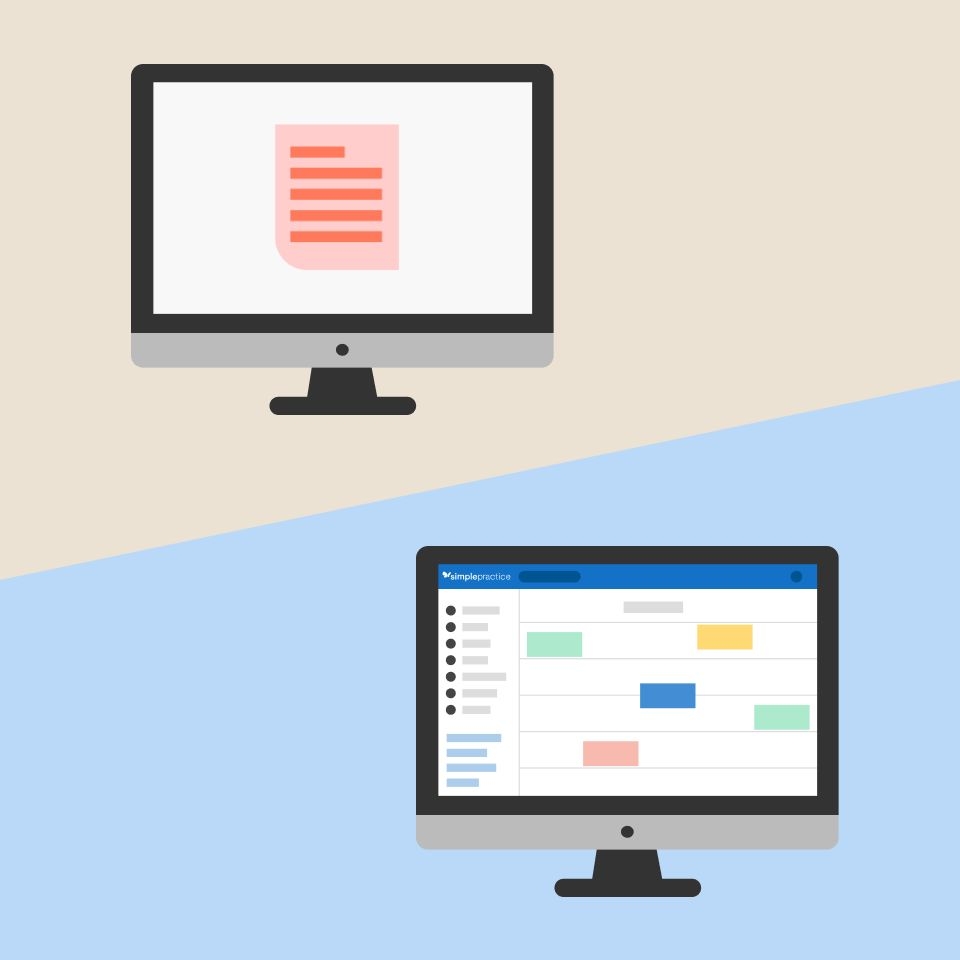What Are the Core Functionalities of an EHR System?
Get a free EHR evaluation checklist
Download free resource
Enter your email below to access this resource.
By entering your email address, you are opting-in to receive emails from SimplePractice on its various products, solutions, and/or offerings. Unsubscribe anytime.

EHR stands for “electronic health record.” An EHR system is a platform that centralizes a patient’s health records.
EHR functionality makes it possible for health providers and practitioners to store and retrieve data, charts, notes, and other information for patients and clients.
Instead of individual health providers having to track down a patient’s written records, EHR software makes it possible for clinicians to gather all the data, charts, notes, and other information from a patient’s different providers—and allows their care team to access and update that information in real time.
There are a variety of benefits of EHRs—both for the patient and for the provider. But what are the core functions of an EHR system—and how do the functionalities of an EHR benefit both patients and providers?
Core EHR functionality
In 2003, as EHRs became more widely adopted, the Department of Health and Human Services (DHHS) commissioned the Institute of Medicine (IOM) to research and report on the key capabilities and benefits of EHRs.
In thinking about EHR functionality, the IOM’s report identified eight primary features.
These core functionalities of an EHR include:
- Health information and data
- Results management
- Order entry/Order management
- Decision support
- Electronic communication and connectivity
- Patient support
- Administrative processes
- Reporting and population health management
Let’s take a look at each EHR functionality in more detail.
Health information and data
As the name suggests, a key administrative function of EHR systems is to house a patient’s electronic health records—or, in other words, their health information and related data. This includes things like lab results, medication information, past diagnoses, and clinical notes.
Having access to this information can help medical, mental health, and other health providers make better, more informed decisions for their patients. It can also help to avoid potential patient issues, like prescribing a medication a patient might have an allergic reaction to or repeating an expensive lab test that’s already been completed.
Results management
Another core EHR functionality is the management of patient results (for example, lab results, radiology results, or x-ray results).
Having digital records of results makes it easier for providers to access results in real-time, when they need them—including results from other offices, hospitals, imaging centers, or providers.
Having access to electronic results also makes it easier for providers to compare current results to past results. This can not only help to eliminate redundant or unnecessary testing, but can also make it easier for providers to spot inconsistent, abnormal, or problematic results—and coordinate appropriate follow-up care and/or testing for the patient.
Order entry/Order management
EHR platforms also make it easier for providers to submit and monitor orders.
This significantly decreases the potential for human error in order entry or management (for example, illegible handwriting or duplicate orders). It also decreases the amount of time providers have to spend entering and managing patient orders—which can significantly increase productivity and allow them to see a higher volume or patients without sacrificing quality.
Decision support
Another key EHR functionality is decision support.
Decision support systems compare a patient’s electronic health records to a computerized knowledge base—and then make recommendations to help the provider make better, more informed decisions for their patients.
For example, decision support might review a patient’s electronic record and recommend the clinician order a preventative health screening or adjust the patient’s medication dosage.
Because decision support systems access a large computerized knowledge base, they can help to improve provider accuracy and productivity and patient outcomes.
Electronic communication and connectivity
In today’s digital culture, the vast majority of people—both providers and patients—prefer electronic communication. EHRs allow patients and providers to exchange secure messages, which protects sensitive patient data and improves the efficacy of patient-provider communication.
Patient support
Another of the important uses of electronic health records is to empower patients by providing them access to patient education resources, home-monitoring materials, and their own health records.
This can help patients better manage their mental and physical health and/or chronic conditions in between office visits—which, in turn, can help improve outcomes.
Administrative processes
Electronic health record systems offer an easy, centralized way to manage administrative processes across different providers, offices, and locations. This includes scheduling appointments/sessions, procedures (both inpatient and outpatient), and hospital visits and admissions; billing and insurance; and patient outreach and management.
Streamlining administrative processes in a private practice EHR reduces the amount of time and energy providers and staff are spending managing administrative tasks, which can increase both productivity and effectiveness.
Reporting and population health management
EHRs also allow providers to transmit relevant clinical information to public health organizations. (For example, a therapist may use their behavioral health EHR to send relevant infection and immunization information to the Centers for Disease Control and Prevention.)
This information allows public health organizations to better understand and address health trends and concerns, as well as create more accurate reports and forecasts.
EHRs support both providers and patients
EHRs allow doctors, clinicians, and other providers to provide a higher level of care to their patients.
Whether they’re evaluating a patient for a specific diagnosis, recommending a medication, or managing their practice, EHR functionality can help providers do their jobs better and more effectively—which is beneficial to both providers and patients.
Try out a private practice EHR for free
After considering the functionality and benefits of an EHR and deciding it makes sense for your practice, all that’s left is to try one out.
Over 178,000 private practice clinicians, use SimplePractice as their HIPAA-compliant practice management software to effectively run their practices. SimplePractice offers key EHR benefits and features that save time and reduce paperwork.
SimplePractice makes it easy to run a fully paperless practice. Upload your client data, whether from another EHR system or from a pen-and-paper practice, and get started running your business right away. Save time with hundreds of custom templates for progress notes, SOAP notes, assessments, intake forms, and more.
Sign up for a free, 30-day trial of SimplePractice to experience the benefits of EHR functionality for your business and your clients.
How SimplePractice streamlines running your practice
SimplePractice is HIPAA-compliant practice management software with everything you need to run your practice built into the platform—from booking and scheduling to insurance and client billing.
If you’ve been considering switching to an EHR system, SimplePractice empowers you to streamline appointment bookings, reminders, and rescheduling and simplify the billing and coding process—so you get more time for the things that matter most to you.
Try SimplePractice free for 30 days. No credit card required.

